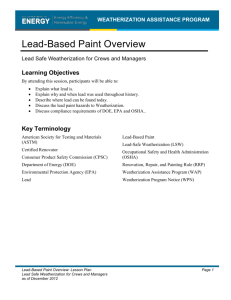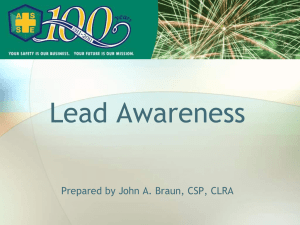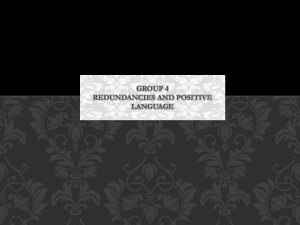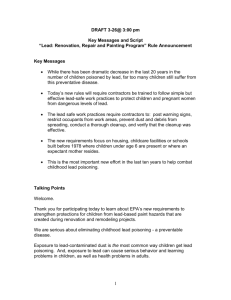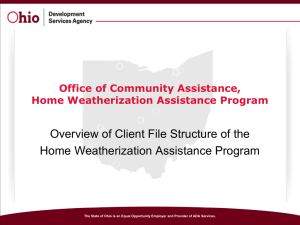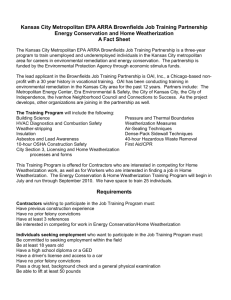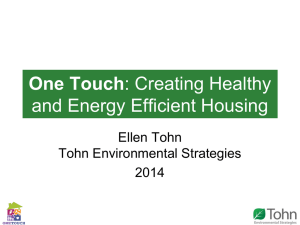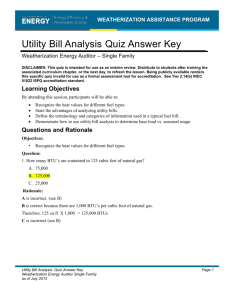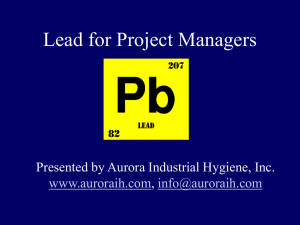Attachment A - Weatherization Assistance Program Technical
advertisement
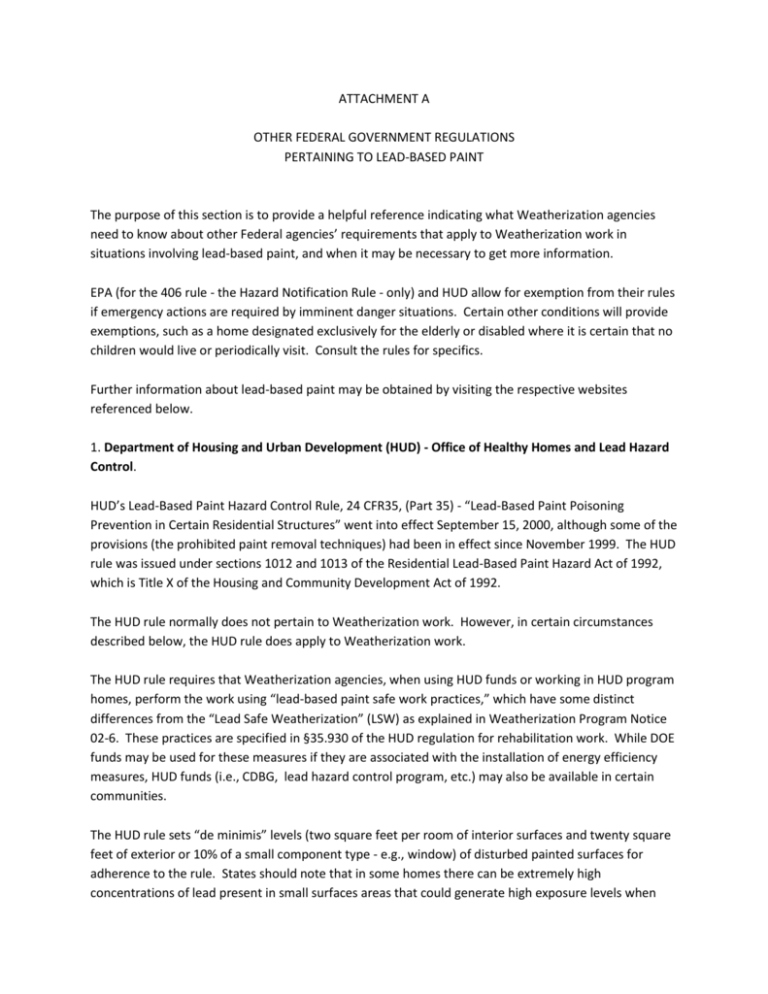
ATTACHMENT A OTHER FEDERAL GOVERNMENT REGULATIONS PERTAINING TO LEAD-BASED PAINT The purpose of this section is to provide a helpful reference indicating what Weatherization agencies need to know about other Federal agencies’ requirements that apply to Weatherization work in situations involving lead-based paint, and when it may be necessary to get more information. EPA (for the 406 rule - the Hazard Notification Rule - only) and HUD allow for exemption from their rules if emergency actions are required by imminent danger situations. Certain other conditions will provide exemptions, such as a home designated exclusively for the elderly or disabled where it is certain that no children would live or periodically visit. Consult the rules for specifics. Further information about lead-based paint may be obtained by visiting the respective websites referenced below. 1. Department of Housing and Urban Development (HUD) - Office of Healthy Homes and Lead Hazard Control. HUD’s Lead-Based Paint Hazard Control Rule, 24 CFR35, (Part 35) - “Lead-Based Paint Poisoning Prevention in Certain Residential Structures” went into effect September 15, 2000, although some of the provisions (the prohibited paint removal techniques) had been in effect since November 1999. The HUD rule was issued under sections 1012 and 1013 of the Residential Lead-Based Paint Hazard Act of 1992, which is Title X of the Housing and Community Development Act of 1992. The HUD rule normally does not pertain to Weatherization work. However, in certain circumstances described below, the HUD rule does apply to Weatherization work. The HUD rule requires that Weatherization agencies, when using HUD funds or working in HUD program homes, perform the work using “lead-based paint safe work practices,” which have some distinct differences from the “Lead Safe Weatherization” (LSW) as explained in Weatherization Program Notice 02-6. These practices are specified in §35.930 of the HUD regulation for rehabilitation work. While DOE funds may be used for these measures if they are associated with the installation of energy efficiency measures, HUD funds (i.e., CDBG, lead hazard control program, etc.) may also be available in certain communities. The HUD rule sets “de minimis” levels (two square feet per room of interior surfaces and twenty square feet of exterior or 10% of a small component type - e.g., window) of disturbed painted surfaces for adherence to the rule. States should note that in some homes there can be extremely high concentrations of lead present in small surfaces areas that could generate high exposure levels when disturbed and endanger residents. This could result in an OSHA citation. In this case, OSHA worker safety regulations govern, and employers are obligated to observe good work practices (explained in the program notice as LSW) to ensure that levels of lead-based paint dust are kept below acceptable levels. See the OSHA regulations below. When the HUD Regulation does apply: The HUD regulation only applies to Weatherization work when all four of the following conditions are true: It is pre-1978 housing, and The dwelling has not been certified to be lead-based paint free, and The amount of disturbed lead-based painted surfaces exceeds two square feet per room of interior surfaces or twenty square feet of exterior surface or 10% of a small component, e.g., window, and Either it is HUD-assisted housing (including HUD Section 8 vouchered housing), and/or HUD funds are being used to weatherize, rehabilitate, or repair the home. When the HUD Regulation does not apply: The HUD rule does not apply to Weatherization work when any one of the following five conditions is true: It is post-1977 housing, or The dwelling has been certified to be lead-based paint free, or The amount of disturbed lead-based painted surfaces is less than two square feet per room of interior surfaces or twenty square feet of exterior surface or 10% of a small component, e.g., window, or The home is neither a HUD program home, nor is HUD money funding the Weatherization work, or related rehabilitation or repair of the home, or The housing is designated exclusively for the elderly or disabled. Website reference: http://www.hud.gov/offices/lead. Also call 1-800-424-LEAD 2. Environmental Protection Agency (EPA) - Office of Pollution Prevention and Toxics. Only one of the EPA rules, section 406 of the Residential Lead-Based Paint Hazard Act of 1992, applies to Weatherization work. This is the Hazard Notification Rule, which became effective June 1, 1999, under EPA Final Rule, 40 CFR Part 745 titled; “Lead; Requirements for Hazard Education Before Renovation of Target Housing.” Under certain, fairly common circumstances (explained below), Section 406 requires Weatherization providers to give a copy of the EPA booklet “Protect Your Family from Lead in Your Home” (publication number: EPA 747-k-94-001) prior to the start of work (if mailed, at least seven days before). The rule also has a record keeping requirements. The EPA publication “The LeadBased Paint Pre-Renovation Education Rule...a handbook for contractors, property managers and maintenance personnel,” EPA-747-B-99-004, September 1999, outlines local agencies’ responsibilities. Multiple copies of both documents can be ordered from the Government Printing Office, 202-512-1800 or 1-866-512-1800. Section 402. The Lead-Based Paint Worker Certification rule does not apply if the intent of doing the work in the home is Weatherization work, therefore, LSW practices utilized while installing energy efficiency measures do not require worker certification. EPA’s new section 403 rule is the Lead Hazard Standard. More information about his rule can be found at http://www.epa.gov/lead/regulation.htm EPA’s Office of Sold Waste memorandum to RCRA Senior Policy Advisors, EPA Regions 1-10, subject: Regulatory Status of Waste Generated by Contractors and Residents from Lead-Based Paint Activities Conducted in Households, from July 2000, allows disposal of everyday household hazardous materials residue or debris containing lead-base paint, like replaced windows or discarded clothing - from homes as nonhazardous waste and thus not subject to toxic chemical disposal rules. Household lead-based paint debris, however, must be handled in a way that will not generate or discharge lead-based paint debris to the environment, either at the client’s home or in transporting to a disposal site. A copy of the EPA Memorandum is posted on the WAPTAC website. The proposed EPA rule referred to as the Renovation Rule has not yet been sent out to Federal government organizations for comment. DOE strongly believes that this rule does not apply to Weatherization work since we limit work to the installation of energy conserving measures to reduce the energy burden on low-income families. We do not consider Weatherization work to be renovation or remodeling activities. When the EPA Regulation does apply: The EPA regulation (section 406) only applies to Weatherization work when all three of the following conditions are true: It is pre-1978 housing, and The dwelling has not been certified to be lead-based free, and The amount of disturbed lead-based painted surfaces will exceed two square feet per room of interior surfaces or twenty square feet of exterior surface. When the EPA Regulation does not apply: The EPA rule does not apply to Weatherization work when any one of the following three is true: It is post-1977 housing, or The dwelling has been certified to be lead-based paint free, or The amount of disturbed lead-based painted surfaces will be less than two square feet per room of interior surfaces or twenty square feet of exterior surfaces; however, it is recommended that Weatherization agencies do hand out the booklet in all cases involving pre-1978 housing, since it is excellent outreach material and the work may change after the job has begun, involving more disturbance of painted surfaces than originally anticipated. Website reference: http://www.epa.gov/lead/ Also, call 1-800-424-LEAD. 3. Occupational Health and Safety Administration (OSHA). Title X, subtitle C, Section 1031 and 1032, Worker Protection, of the Housing and Community Development Act of 1992 amended the Occupational Safety and Health Administration (OSHA) standards for occupational health and environmental controls in Subpart D of 29 CFR part 1926 by adding a new Section 1926.62 containing employee protection requirements for construction workers (includes Weatherization workers) exposed to lead. In general, when painted surfaces are disturbed and lead paint is suspected, workers should perform the work in a way that will contain the generated lead dust. The OSHA Construction Standard (1926.62), Good Work Practices, requires that employers assure that good work practices are followed when worker exposure to lead exceeds the action level, which is an 8-hour Time Weighted Average (TWA) of 30 ug/m3 (micro grams per cubic meter). For Weatherization agencies, LSW practices are deemed to constitute the “good work practices” referred to in this rule. Further compliance activities are required if worker exposure to lead exceeds the Permissible Exposure Level (PEL), which is an 8-hour TWA of 50 ug/m3. Actual measurement of on-site exposure levels is difficult and expensive. When judging the proper level of worker protection for compliance with the OSHA lead exposure regulations, employers may substitute laboratory test results, if they are for comparable activities, in lieu of actual on-site monitoring data. Battelle National Laboratory did some testing to determine exposure levels to lead dust for certain (not all) tasks associated with Weatherization activities. These test results are posted on the WAPTAC website. For these tasks, where the levels of lead-based paint dust can be predicted to be less than the action level, the Weatherization agencies need not employ most LSW practices in order to be in compliance with the OSHA rule. In houses where there is the potential for lead exposure, and where Weatherization workers will be performing tasks for which comparable laboratory data are not available, assume that the action level is exceeded and ensure that workers follow LSW procedures. The Weatherization Program, as well as several states, is performing studies to determine the level of lead-based paint dust generated by typical Weatherization activities. The results are expected in late Fall this year and we will keep you posted. When the OSHA Regulation does apply: The OSHA rule always applies when painted surfaces are disturbed and workers are exposed to a lead-based paint hazard. When the exposure exceeds the action level and the PEL, i.e., an 8hour TWA of, respectively, 30 and 50ug/cubic meter, employers are required to have workers observe further precautions. The action level triggers several ancillary provisions of the standard such as exposure monitoring, medical surveillance, and training. Additional requirements must be observed when the PEL is exceeded. When the OSHA Regulation does not apply: The OSHA Standard always applies; the amount of protection and measures taken varies according to the exposure. If the agency has objective data from test results, or similar operating experience, showing that the particular Weatherization activities being conducted do not exceed the action level, even when lead-based painted surfaces are disturbed, then most of the OSHA standards do not apply. Website references: http://www.osha.gov/pls/oshaweb/owadisp.show_document http://www.osha-slc.gov/pls/oshaweb/owadisp.show_document 4. State and Local Requirements. Finally, Weatherization program managers should always consult local and state regulations, as they may be more stringent than those of the Federal Government. If so, they must be followed. If they haven’t already, WAP Grantees are encouraged to establish contacts in their state offices with lead-based paint training and certification program managers.
